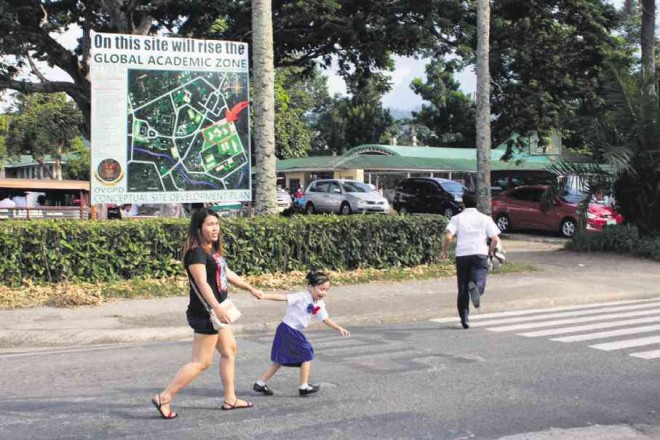
A PUPIL of Maquiling School Inc. (MSI) pulls her mother as they cross the street. Behind them is the signage announcing that the University of the Philippines Los Baños, to which MSI is leasing the property, is putting up a “global academic zone” on the site. CLIFFORD NUÑEZ/CONTRIBUTOR
Outside the steel gate of Maquiling School Inc. (MSI) at the heart of the sprawling main campus of the University of the Philippines Los Baños (UPLB) in Laguna province hangs a large sign that may mean the doom of the 91-year-old learning institution: A “global academic zone” will soon rise on the property.
“We were hoping to stay (in the current location) until our 100th year, but they (UPLB officials) said we couldn’t anymore because they are using the land for something else,” says Lorna Paje-Angeles, the school principal and a sister of Environment Secretary Ramon Paje.
With old-style capiz windows and wooden classroom walls, MSI stands next to what was once the university’s administration edifice and is surrounded by college buildings. A nonstock, nonprofit institution, the school leases 1.2 hectares of UPLB property for P3,000 per year.
End of lease contract
But the school’s current 25-year agreement, which had already been renewed in the past, is set to expire in April 2016. Angeles says she and the other school officials are hoping that UPLB will give them ample time to transfer to a new facility “phase by phase” so as not to interrupt the academic years ahead.
While teachers and alumni are racing against time to fund the construction of the new 40-classroom building, even school officials doubt that they could put it up in time for the next school opening.
MSI was founded in April 1924, by Maquiling School Club, whose formation was led by Dr. Bienvenido M. Gonzales of the UP College of Agriculture. Surviving World War II, it is probably the oldest basic education school in Los Baños, catering primarily to dependents of university employees.
According to its website, the school started its first class of five kindergarten pupils on May 5, 1924. It was incorporated in November 1932, and was given a building of its own, pursuing Gonzales’ dream of “a top-rated, service-oriented and model school system.”
During World War II, Japanese soldiers transformed the school into a garrison in 1942 and burned it when they retreated on Feb. 27, 1945. MSI was later rebuilt as a hospital and a rest-and-recreation building for American soldiers. Classes resumed in 1945.
The reconstruction of MSI was completed on March 22, 1950. Currently, it has 734 elementary and high school students, and 79 faculty and staff members.
According to Gregorio Pascual from UPLB’s Office of the Vice Chancellor for Planning and Development, the global academic zone project involves building a modern building to make UPLB globally competitive. He has confirmed MSI’s transfer though the university has yet to issue an official statement regarding the details.
Replacement site
Pascual says UPLB is offering MSI another land to lease in the neighboring town of Bay, which is quite far from the main campus.
The site is thrice the size of the current one, with an area of about four hectares, Angeles says. Nothing is clear yet as to the terms of the new lease arrangement.
The principal sees an advantage in the proposed location as it puts MSI right next to UP Rural High School. But some parents are worried that the transfer may force the school to shut down.
“How is it going to be? Construction (of a new building) has not even started yet, not even a groundbreaking (on the new site). We’re on a wait-and-see situation,” says Emma Jimenez, 48, a mother of a grade schooler. “They haven’t told us of any concrete plan yet.”
Other parents who have heard of the plan have already pulled out their children from MSI or were considering the transfer of their children to other schools next year.
Striving for continuity
Angeles has quickly allayed fears of a shutdown, saying she and the other officials are working to ensure the school’s continued operations. Some alumni have pledged help, she says, while the teachers have started selling shirts marked with the school logo and other activities to raise at least P20 million for the construction of the new building.
Some parents have even pledged sacks of cement.
Every afternoon, pupils in navy blue and white uniforms could be seen behind the school’s wired fence, playing after class. Parents begin filling up the seats at the waiting area to pick up their wards.
“It gives (the university) a different sense when you see children around the campus,” Angeles says. “MSI will still be here. It will only transfer its location but it will still be present.”

